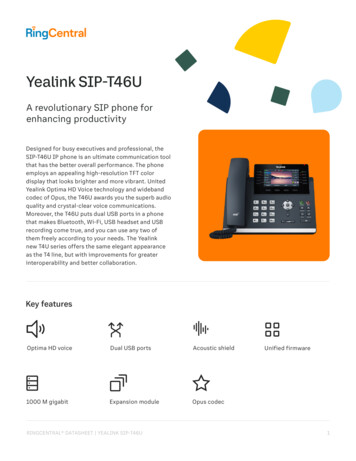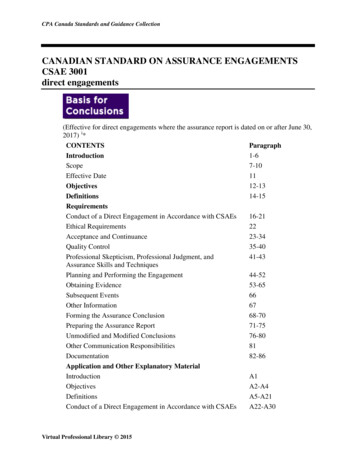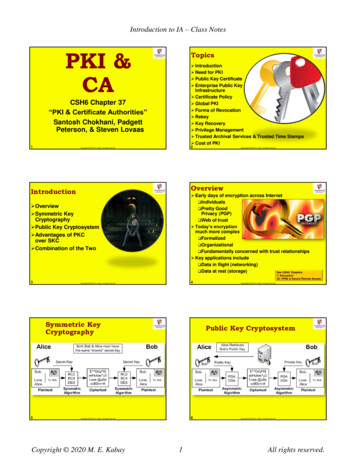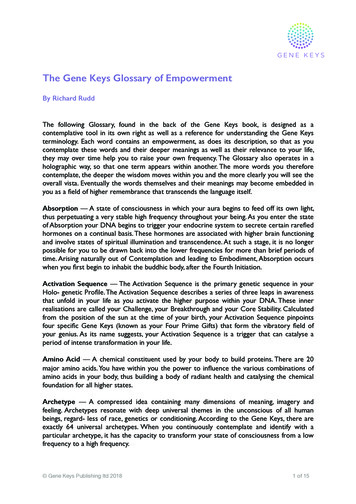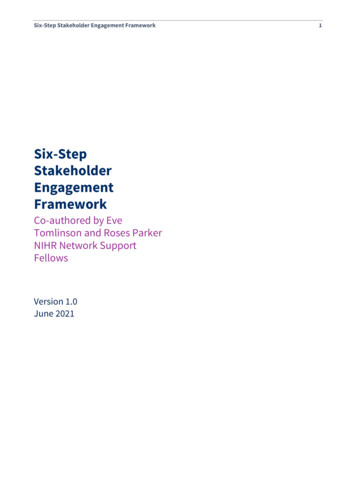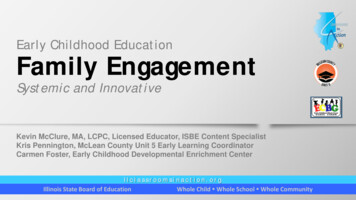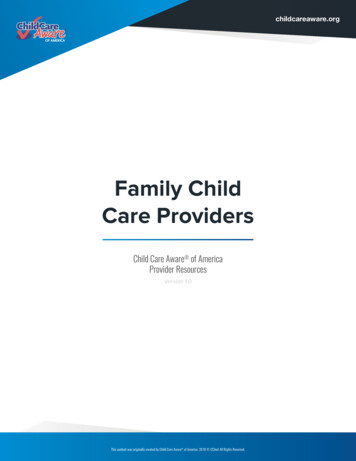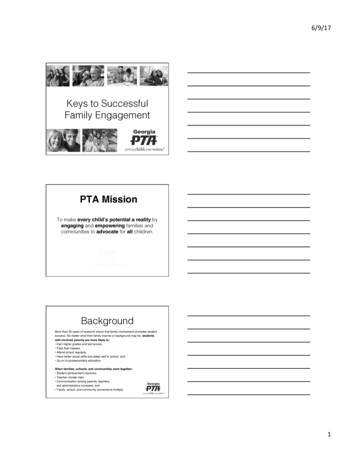
Transcription
6/9/17Keys to SuccessfulFamily Engagement !PTA MissionTo make every child’s potential a reality byengaging and empowering families andcommunities to advocate for all children.!Background!More than 30 years of research shows that family involvement promotes studentsuccess. No matter what their family income or background may be, studentswith involved parents are more likely to: Earn higher grades and test scores, Pass their classes, Attend school regularly, Have better social skills and adapt well to school, and Go on to postsecondary education.When families, schools, and communities work together: Student achievement improves, Teacher morale rises, Communication among parents, teachers,and administrators increases, and Family, school, and community connections multiply.1
6/9/17Standard 1—Welcoming AllFamilies into the School Community!Questions to ask:When families walk into the building, do they feel the school isinviting and is a place where they “belong”?Do the school’s policies and programs reflect, respect, and valuethe diversity of the families in the community?Standard 1—Welcoming AllFamilies into the School Community!Keys to Success:1. Establish a PTA welcoming committee responsible for identifying ways to makeall families feel welcome.2. Recruit bilingual parents to greet and interpret for families whose first languageisn’t English.3. Offer family activities at low or no cost so everyone can participate;budget PTA funds for this purpose.4. Hold meetings in a variety of community locations (e.g., the local library,a community center, a church) to make them accessible to all.5. Greet other parents at school activities and events; sit with someoneyou don’t know and get to know them.2
6/9/17Standard 2—CommunicatingEffectively!Question to ask:Does the school keep all families informed aboutimportant issues and events and make it easy forfamilies to communicate with teachers?Standard 2—CommunicatingEffectively!Keys to Success:1. Make use of all channels of communication: automated phone systems,text messaging, school and PTA websites, social media (Facebook, Twitter),eblasts, traditional paper flyers and newsletters, etc.2. Make sure all information is communicated in languages and formats to reachall parents.3. Host events that allow educators and parents to interact socially(coffee chats with the principal, for example)4. Role-play a parent-teacher conference for families and school staff,demonstrating effective ways for parents and teachers to share informationand plan for the future.5. Survey your parents to get their feedback on your programs and on theschool’s needsStandard 3—SupportingStudent Success!Questions to ask:Do families know and understand how welltheir children are succeeding in school and how wellthe entire school is progressing?Are families active participants in their children’slearning at home and at school?3
6/9/17Standard 3—SupportingStudent Success!Keys to Success:1. Determine what parents need to know and need to be able todo to support their children’s academic success. Alsodetermine how family and community engagement cansupport school goals.2. Work with school leadership to conduct workshops for parentsand students on study skills, individual curriculum areas,standardized tests, and college and career planning.3. Create a checklist and tip sheets for effective parent-teacherconferences.4. Provide parent involvement suggestions through signs at theschool and articles in the local newspaper.5. Link all events to student learning.Standard 4—Speaking Upfor Every Child!Questions to ask:Do parents know how the local school and district operate andhow to raise questions or concerns about school and districtprograms, policies, and activities?Do they understand their rights and responsibilities under federaland state law as well as local ordinances and policies?Are parents prepared to monitor students’ progress and guidethem toward their goals through high school graduation,postsecondary education, and a career?Standard 4—Speaking Upfor Every Child!Keys to Success:1. Involve parents in ongoing training on topics such as being an effectiveadvocate, identifying and supporting learning styles, resolving difficulties,and fostering student achievement.2. Get a copy of your school’s parent involvement policy and work with schoolleadership to update the policy to meet the needs of your community.3. Include a one-question poll in each PTA/school newsletter and post it on yourwebsite. Over the course of the year, cover a wide range of issues affectingstudents and the school. Use the parent feedback in making school andprogram decisions.4. Reach out to underrepresented populations to ensure access and equity for allstudents.4
6/9/17Standard 5—Sharing Power!Questions to ask:Are all families full partners in making decisions thataffect their children at school and in the community?Do families have a strong, broad-based organizationthat offers regular opportunities to develop relationshipsand raise concerns with school leaders, public officials, andbusiness and community leaders?Standard 5—Sharing Power!Keys to Success:1. Make sure the PTA membership and leadership is reflective of the schoolcommunity.2. Work with the principal to identify ways the school can include and consultparents in decisions and ways the PTA can support the school improvementplan.3. Work with students, parents, teachers, school and community leaders, andbusinesses to develop a parent/family involvement policy that establishes thefoundation for involvement programs in your community.4. Host a forum for candidates running for public office; focus questions on issuesthat affect children, families, and education.5. Get to know your elected officials at all levels of government.Standard 6—Collaboratingwith the Community!Question to ask:Do parent and school leaders work closely withcommunity organizations, businesses, and institutions ofhigher education to strengthen the school, make resourcesavailable to students, school staff, and families,and build a family-friendly community?5
6/9/17Standard 6—Collaboratingwith the Community!Keys to Success:1. Reach out to a broad base of partners in and around the school to helpachieve your desired results. Develop a shared vision of success among yourpartners and an understanding of the contributions each organization canbring.2. Host a community-resource fair highlighting programs that support the cultural,recreational, academic, health, social, and other needs of families.3. Invite senior/retired citizens to volunteer at the school. Also, invite high schoolstudents to volunteer at your elementary school events.4. Create a school alumni program to encourage alumni to volunteer time ormake a donation to the school.5. Work with the local newspaper to promote events at the school.National PTA School ofExcellence!National PTA School of Excellence is a recognition program thatsupports and celebrates partnerships between PTAs and schools toenrich the educational experience and overall well-being for all students.As a National PTA School of Excellence, families feel welcomed andempowered to support student success, and PTA is a key partner forcontinuous school improvement.6
6/9/17Resources!Georgia and National PTAEducational & Programmatic resources(www.georgiapta.org and www.pta.org)Your School’s Improvement PlanGeorgia Department of Education (www.gadoe.org)Parent Engagement ProgramResources!7
6/9/17PTA MissionTo make every child’s potential a reality byengaging and empowering families andcommunities to advocate for all children.!8
Are all families full partners in making decisions that . Standard 5—Sharing Power! Keys to Success: 1. Make sure the PTA membership and leadership is reflective of the school community. 2. Work with the principal to identify ways the school can include and consult parents in decisions and ways the PTA can support the school improvement


